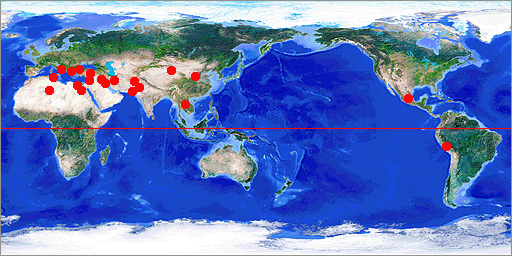What is Space Archaeology ?
Birthplaces of ancient civilizations in the world is related to water deeply.
The Egyptian civilization was originated in the Nile basin, the Mesopotamian civilization was in the Tigris Euphrates River basin, the Indus Civilization was in the Indus River basin and the Chinese civilization was originated in the Yellow River and Chang Jiang river basin.
Altough the human made a long history along those big rivers, by investigating ancient cities and remains of the world, it is proved that almost all of them range over a very arid desert area in the middle latitude zone.
This doesn't suggest that civilization did not originate in desert zone, but suggests that there was an environmental change causing desertification in the area and a condition of human life has changed.
A study concerning civilization and environmental change like this is not only to make clear the local historical facts, but also it is helpful to solve to the recent global environment problems on greenhouse warming, deforestation, as well as it can be a very important clue to predict future environment change.
Since Landsat1 was launched in 1972, earth observation technology using satellite data was applied to investigations in the various fields such as the environment, disaster, meteorology, ocean, etc., and obtained many good results.
By the improvement of ground resolution for infrared sensor and microwave sensors, it became possible to observe earth surface phenomena more exactly, so that a range of satellite data application is diversifying, and it became possible to detect of hidden remains in a dense forest or desert area too.
This study, applying information technology from space to archaeology, and studying about remains and ancient environments of the places which there was civilizations once as monitoring the present earth environments, is called " Space Archaeology".

Distribution of ancient cities and remains ©TRIC
●: Main ancient cities and remains


